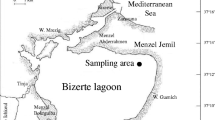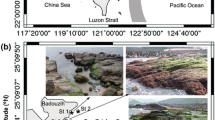Abstract
The communities of gammaridean amphipods associated with eight dominant macroalgal species were examined near Palmer Station, Western Antarctic Peninsula. A total of 78,415 individuals belonging to 32 amphipod taxa were identified with mean densities ranging up to 20 individuals/g algal wet wt. The most abundant amphipod taxon, Metaleptamphopus pectinatus, was found to associate predominately with the brown alga Desmarestia menziesii, while the second most common taxon, Jassa spp. occurred primarily on the red alga Gigartina skottsbergii. Non-metric multidimensional scaling analysis demonstrated that the population densities of each amphipod species and amphipod species composition were similar on the same algal species but dissimilar on different species of algae. Comparisons of amphipod communities associated with a given algal species but from different sampling sites indicated that although the structure of species-specific macroalgal-associated amphipod communities can vary across spatial scales of 3 km, 50% of the macroalgal species examined showed no significant inter-site differences in associated amphipod community structure. Spearman rank correlation analyses showed that higher abundances of amphipods occurred on the macroalgae with the highest number of branches. As many Antarctic amphipods are known consumers of macroalgae, their remarkable abundances are likely to play a significant role in mediating energy and nutrient transfer in nearshore Antarctic Peninsular macroalgal communities.






Similar content being viewed by others
References
Aikins S, Kikuchi E (2001) Water current velocity as an environmental factor regulating the distribution of amphipod species in Gamo Lagoon, Japan. Limnology 2:185–191
Amsler CD, Rowley RJ, Laur DR, Quetin LB, Ross RM (1995) Vertical distribution of Antarctic peninsular macroalgae: cover, biomass and species composition. Phycologia 34:424–430
Amsler CD, McClintock JB, Baker BJ (1998) Chemical defense against herbivory in the Antarctic marine macroalgae Iridaea cordata and Phyllophora antarctica (Rhodophyceae). J Phycol 34:53–59
Amsler CD, Iken K, McClintock JB, Amsler MO, Peters KJ, Hubbard JM, Furrow FB, Baker BJ (2005) Comprehensive evaluation of the palatability and chemical defenses of subtidal macroalgae from the Antarctic Peninsula. Mar Ecol Prog Ser 294:141–159
Barrera-Oro ER, Casaux RJ (1990) Feeding selectivity in Notothenia neglecta, Nybelin, from Potter Cove, South Shetland Islands, Antarctica. Antarctic Sci 2:207–213
Buschmann AH (1990) Intertidal macroalgae as refuge and food for Amphipoda in central Chile. Aquat Bot 36:237–245
Chemello R, Milazzo M (2002) Effect of algal architecture on associated fauna: some evidence from phytal molluscs. Mar Biol 140:981–990
Clarke KR, Warwick RM (2001) Change in marine communities: an approach to statistical analysis and interpretation. PRIMER-E Plymouth
Cruz-Rivera E, Hay ME (2000) Can quantity replace quality? Food choice, compensatory feeding, and fitness of marine mesograzers. Ecology 81:201–219
Cruz-Rivera E, Hay ME (2001) Macroalgal traits and the feeding and fitness of an herbivorous amphipod: the roles of selectivity, mixing, and compensation. Mar Ecol Prog Ser 218:249–266
Dayton PK, Robilliard GA, Paine RT, Dayton LB (1974) Biological accommodation in the benthic community at McMurdo Sound, Antarctica. Ecol Monogr 44:105–128
DeLaca TE, Lipps JH (1976) Shallow-water marine associations, Antarctic Peninsula. Antarct J US 11:12–20
Dhargalkar VK, Burton HR, Kirkwood JM (1988) Animal associations with the dominant species of shallow water macrophytes along the coastline of the Vestfold Hills, Antarctica. Hydrobiologia 165:141–150
Dixon IMT, Moore PG (1997) A comparative study on the tubes and feeding behaviour of eight species of corophioid Amphipoda and their bearing on phylogenetic relationships within the Corophioidea. Philos Trans Biol Sci 352:93–112
Duffy JE, Hay ME (1994) Herbivore resistance to seaweed chemical defense: the roles of mobility and predation risk. Ecology 75:1304–1319
Duggins D, Eckman JE, Siddon CE, Klinger T (2001) Interactive roles of mesograzers and current flow in survival of kelps. Mar Ecol Prog Ser 223:143–155
Edgar GJ (1983) The ecology of south-east Tasmanian phytal animal communities. IV. Factors affecting the distribution of ampithoid amphipods among algae. J Exp Mar Biol Ecol 70:205–225
Fairhead VA, Amsler CD, McClintock JB, Baker BJ (2005) Within-thallus variation in chemical and physical defences in two species of ecologically dominant brown macroalgae from the Antarctic Peninsula. J Exp Mar Biol Ecol 322:1–12
Gambi MC, Lorenti M, Russo GF, Scipione MB (1994) Benthic associations of the shallow hard bottoms off Terra Nova Bay, Ross Sea: zonation, biomass and population structure. Antarctic Sci 6:449–462
Gambi MC, Buia MC, Mazzella L, Lorenti M, Scipione MB (2000) Spatio-temporal variability in the structure of benthic populations in a physically controlled system off Terra Nova Bay: the shallow hard bottoms. In: Faranda FM, Guglielmo L, Ionora (eds) Ross Sea Ecology. Springer, Heidelberg, pp 527–538
Graeve M, Dauby P, Scailteur Y (2001) Combined lipid, fatty acid and digestive tract content analyses: a penetrating approach to estimate feeding modes of Antarctic amphipods. Polar Biol 24:853–862
Hacker SD, Steneck RS (1990) Habitat architecture and the abundance and body-size-dependent habitat selection of a phytal amphipod. Ecology 71:2269–2285
Hay ME (1996) Marine chemical ecology: what’s known and what’s next? J Exp Mar Biol Ecol 200:103–134
Hay ME (1997) The ecology and evolution of seaweed-herbivore interactions on coral reefs. Coral Reefs 16:S67–S76
Hay ME, Fenical W (1988) Marine plant-herbivore interactions: the ecology of chemical defense. Ann Rev Ecol Syst 19:111–145
Holmlund MB, Peterson CH, Hay ME (1990) Does algal morphology affect amphipod susceptibility to fish predation? J Exp Mar Biol Ecol 139:65–83
Huang YM, McClintock JB, Amsler CD, Peters KJ (2006) Feeding rates of common Antarctic gammarid amphipods on ecologically important sympatric macroalgae. J Exp Mar Biol Ecol 329:55–65
Hughes RN, Gliddon CJ (1991) Marine plants and their herbivores: coevolutionary myth and precarious mutualisms. Phil Trans E Soc Lond 333:231–239
Iken K (1999) Feeding ecology of the Antarctic herbivorous gastropod Laevilacunaria antarctica Martens. J Exp Mar Biol Ecol 236:133–148
Iken K, Barrera-Oro ER, Quartino M-L, Casaux RJ, Brey T (1997) Grazing by the Antarctic fish Notothenia coriiceps: evidence for selective feeding on macroalgae. Antarctic Sci 9:386–391
Iken K, Quartino M-L, Barrera-Oro E, Palermo J, Wiencke C, Brey T (1998) Trophic relations between macroalgae and herbivores. Rpt Polar Res 299:258–262
Iken K, Quartino M-L, Wiencke C (1999) Histological identification of macroalgae from stomach contents of the Antarctic fish Notothenia coriiceps using semi-thin sections. Mar Ecol 20:11–17
Jaźdźewski K, De Broyer C, Teodorczyk W, Konopacka A (1991a) Survey and distributional patterns of the amphipod fauna of Admiralty Bay, King George Island, South Shetland Islands. Pol Polar Res 12:461–472
Jaźdźewski K, Teodorczyk W, Sicinski J, Kontek B (1991b) Amphipod crustaceans as an important component of zoobenthos of the shallow Antarctic sublittoral. Hydrobiologia 223:105–117
Jernakoff P, Brearley A, Nielsen J (1996) Factors affecting grazer-epiphyte interactions in temperate seagrass meadows. Oceanogr Mar Biol Ann Rev 34:109–62
John DM, Hawkins SJ, Price JH (1992) Plant–animal interactions in the marine benthos. Oxford University Press, New York
Lippert H, Iken K, Rachor E, Wiencke C (2001) Macrofauna associated with macroalgae in the Kongsfjord (Spitsbergen). Polar Biol 24:512–522
Lubchenco J (1978) Plant species diversity in a marine intertidal community: importance of herbivore food preference and algal competitive abilities. Am Nat 112:23–39
Martin-Smith KM (1993) Abundance of mobile epifauna: the role of habitat complexity and predation by fishes. J Exp Mar Biol Ecol 174:243–260
McCune B, Grace JB (2002) Analysis of ecological communities, Vol. MjM software design, Gleneden Beach, Oregon, USA
McGarigal K, Cushman S, Stafford S (2000) Multivariate statistics for wildlife and ecology research. Springer, New York
Moe RL, DeLaca TE (1976) Occurrence of macroscopic algae along the Antarctic Peninsula. Antarct J US 11:20–24
Mukai H, Iijima A (1995) Grazing effects of a gammaridean Amphipoda, Ampithoe sp., on the seagrass, Syringodium isoetifolium, and epiphytes in a tropical seagrass bed of Fiji. Ecol Res 10:243–257
Neushul M (1965) Diving observations of sub-tidal antarctic marine vegetation. Bot Mar 8:234–243
Parker JD, Duffy JE, Orth RJ (2001) Plant species diversity and composition: experimental effects on marine epifaunal assemblages. Mar Ecol Prog Ser 224:55–67
Pavia H, Carr H, Åberg P (1999) Habitat and feeding preferences of crustacean mesoherbivores inhabiting the brown seaweed Ascophylum nodosum (L.) Le Jol. and its epiphytic macroalgae. J Exp Mar Biol Ecol 236:15–32
Richardson MG (1977) The ecology (including physiological aspects) of selected Antarctic marine invertebrates associated with inshore macrophytes. PhD Dissertation, University of Durham
Romesburg HC (1984) Cluster analysis for researchers. Krieger Publishing Company, Melbourne
Sotka EE, Hay ME, Thomas JD (1999) Host-plant specialization by a non-herbivorous amphipod: advantages for the amphipod and costs for the seaweed. Oecologia 118:472–482
Sparrevik E, Leonardsson K (1999) Direct and indirect effects of predation by Saduria entomon (Isopoda) on the size-structure of Monoporeia affinis (Amphipoda). Oecologia 120:77–86
Stachowicz JJ, Hay ME (1999) Reducing predation through chemically mediated camouflage: indirect effects of plant defenses on herbivores. Ecology 80:495–509
Takeuchi I, Watanabe K (2002) Mobile epiphytic invertebrates inhabiting the brown macroalga, Desmarestia chordalis, under the coastal fast ice of Lutzow-Holm Bay, East Antarctica. Polar Biol 25:624–628
Thurston MH (1972) The crustacea amphipoda of Signy Island, South Orkney Islands. Br Antarctic Surv Sci Rep 71:1–133
Thurston MH (1973) Crustacea amphipoda from Graham Land and the Scotia Arc, collected by operation Tabarin and the Falkland Islands dependencies survey, 1944–59. Br Antarctic Surv Sci Rep 85: 1-89
Wessels H, Hagen W, Molis M, Wiencke C, Karsten U (2006) Intra- and interspecific differences in palatability of Arctic macroalgae from Kongsfjorden (Spitsbergen) for two benthic sympatric invertebrates. J Exp Mar Biol Ecol 329:20–33
Wiencke C, Clayton MN (2002) Synopses of the antarctic benthos: antarctic seaweeds, Vol 9. A.R.G. Gantner Verlag KG, Rugell
Wooster DE (1998) Amphipod (Gammarus minus) responses to predators and predator impact on amphipod density. Oecologia 115:253–259
Zaneveld JS (1966) The occurrence of benthic marine algae under shore fast-ice in the western Ross Sea, Antarctica. Proc Int Seaweed Symp 5:217–231
Acknowledgements
We thank Anne Fairhead and Kevin Peters for assistance in the field. Assistance with amphipod taxonomy from Kathy Conlan and Ed Hendrycks is very much appreciated. We thank Huichien Kuo for assistance with graphics and SAS programming and five anonymous reviewers for constructive advice on an earlier version of the manuscript. We wish to also thank those individuals employed by Raytheon Polar Services for providing valuable logistical support in Antarctica. This research was facilitated by the generous support of the Office of Polar Programs of the National Science Foundation to C. D. A. and J. B. M. (OPP-0125181) and to B. J. B. (OPP-0125152). Support from an Endowed University Professorship in Polar and Marine Biology to J. B. M. is also acknowledged.
Author information
Authors and Affiliations
Corresponding author
Rights and permissions
About this article
Cite this article
Huang, Y.M., Amsler, M.O., McClintock, J.B. et al. Patterns of gammaridean amphipod abundance and species composition associated with dominant subtidal macroalgae from the western Antarctic Peninsula. Polar Biol 30, 1417–1430 (2007). https://doi.org/10.1007/s00300-007-0303-1
Received:
Revised:
Accepted:
Published:
Issue Date:
DOI: https://doi.org/10.1007/s00300-007-0303-1




